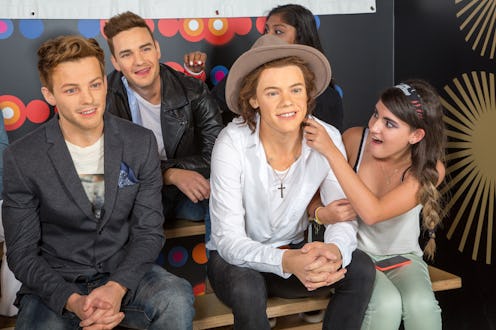Entertainment
5 Celebrities Who Had Even Crazier Fans Than OD
If you have either a teenage sister or a One Direction obsession, you'll be aware that the universe has just ended (again): Louis Tomlinson, a member of the British pop group, has announced he's expecting a baby with an ex-flame. The Twitter and social media response has been amazing, vitriolic and hysterical; Kim Kardashian wishes she could break the Internet like millions of heartbroken teenage girls can. But one thing it isn't? New. Celebrities have inspired hysteria in their fans for centuries — and the screaming, bereaved hashtags of the Louis-lovers barely touch the sides of what fans can really do when their obsession goes off the rails.
The notion of screaming "fandoms" has been around for a while, but really came into its own with the widespread teenage obsession with the Beatles in the 1960s, which produced scenes of such mass hysteria that police and psychologists got involved. The fans who've made the news have tended to be female fans of male musicians and actors. There are a few theories about this: One is that ardent fans tend to be young girls exploring their romantic feelings with a "safe" crush on a beloved but distant figure. Another is that, while men have been able to be hysterical in public — at, say, a sports match —without much comment for a long time, female public emotion is actually a fairly new thing. After centuries of prim demure behaviour control, the sight of girls completely, openly losing their sh*t over something is actually pretty liberating.
But there are limits. Death threats, suicides, property destruction, madness and stealing trousers: it's all in this list of history's most extraordinary episodes of fan hysteria. Louis Tomlinson is, compared to this lot, pretty lucky.
1. Franz Listz
Classical music isn't normally associated with utter devotion and emotional histrionics, but that's because you aren't alive in the heyday of Franz Listz, the composer and pianist of the 19th century. Apparently concerts rapidly descended into utter free-for-alls as fans fainted, attempted to cut off his hair or steal his clothes, or nab any piano strings that he'd happened to break in the course of the performance. Heinrich Heine called the phenomenon "Listzomania."
Listz himself was an egocentric, charismatic man who was also a bit of a fop. He seemed to view the attention as a completely normal part of his own difficult destiny as a genius. After all, this was a man who was prone to saying things like "Sorrowful and great is the artist's destiny."
2. Rudolph Valentino
Ain't no heartthrob like a silent movie heartthrob, and there was nobody like Rudolph Valentino, who dominated the silver screen as a smouldering hottie until his untimely death at the age of 31, in 1926. The ensuing scenes of grief and mass hysteria, both at his funeral and around the world, became the benchmark for obsessive fan behavior.
Several suicides were blamed on Valentino's death, including two attempts outside the hospital where he died, and the funeral was reportedly 100,000 people strong and nearly turned into a window-smashing riot. Fan conspiracies that Valentino wasn't dead but blind or mad continued for years. One (rather unstable) woman was so enamored that she claimed he had been dictating her grocery list from beyond the grave.
3. Frank Sinatra
He wasn't all blue eyes and Mafia connections; Sinatra is actually credited with causing one of the first performance-inspired riots in pop music. On October 12, 1944, Sinatra performed at New York's Paramount Theatre, and the resulting hysterical chaos meant that the occasion was known to historians (and aspiring musicians) as the Columbus Day Riot.
Over 30,000 girls took part in "a phenomenon of mass hysteria that is only seen two or three times in a century," as the New Republic called it. Actually, the riot was fairly minimal as far as hysterical fans go: nobody smashed anything, the performer escaped alive with all his clothes, and the police maintained order (mostly). It was, however, indicative of what the '50s and '60s would bring.
4. The Beatles
How could we talk about extreme fan behavior without talking about Beatlemania? It was such a cultural phenomenon that it's made its way into the Oxford English Dictionary — which describes the behavior as "frenzied". A Scottish promoter who staged one of the Beatles' first post-success gigs described it as "pandemonium. Girls fainting, screaming, wet seats. The whole hall went into some kind of state, almost like collective hypnotism." The Beatles had arrived, and fan hysteria had appeared with them.
It was cross-cultural and completely bonkers; John Lennon wasn't exaggerating (really) when he said the band were "bigger than Jesus". Thirty-five percent of the entire American population watched their performance on the Ed Sullivan Show in 1964. Cultural anthropologists have made grand claims that the mania inspired by the Beatles could never actually happen again; cultural conditions were just right for young people across several continents to be swept up.
5. Elvis Presley
Elvis The Pelvis may appear to us in his rhinestone-encrusted, obese glory in the form of impersonators, but as a young hip-swivelling dynamo he inspired some of the lustiest, most ardent fans in the world. And they required a lot of police power to stop them from tearing him to pieces.
When he performed at the Missisippi-Alabama Fair in 1956, 100 National Guardsmen had to be called in just to stop fans from toppling the barriers and smothering him — and photos show them tearing off his clothes and even hair if they got within range. There are numerous reports of him nearly losing his trousers. And in the same year, a press photographer captured 2000 fans nearly breaking a police barricade to get backstage at his concert at the Olympia in Miami. It was chaos of an epic kind — but not, as we've seen, unprecedented.
Images: Wikimedia Commons (3)
